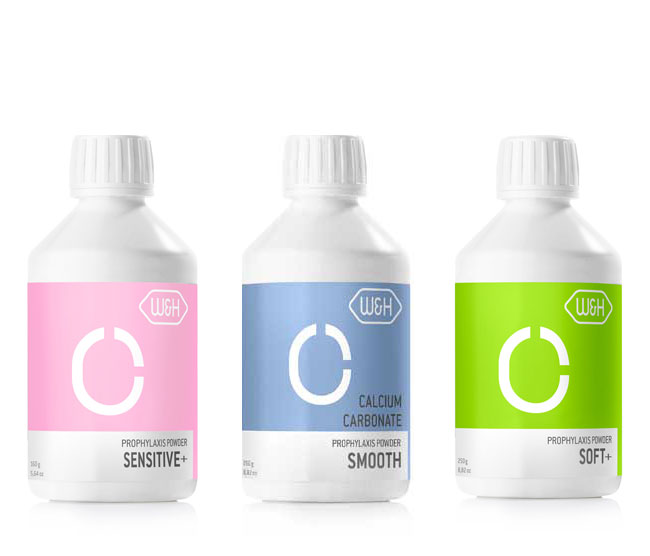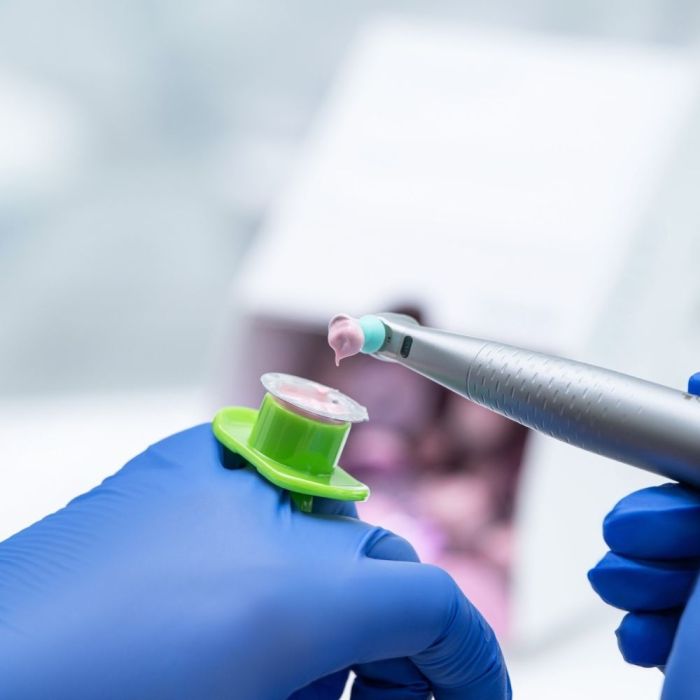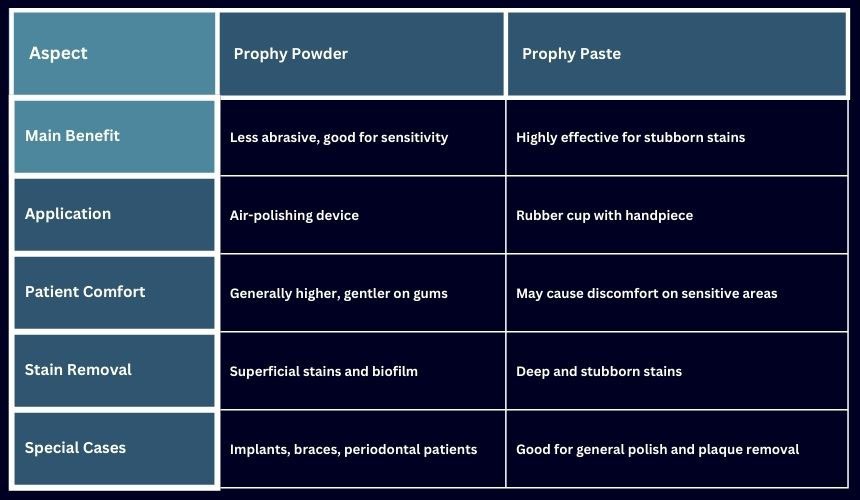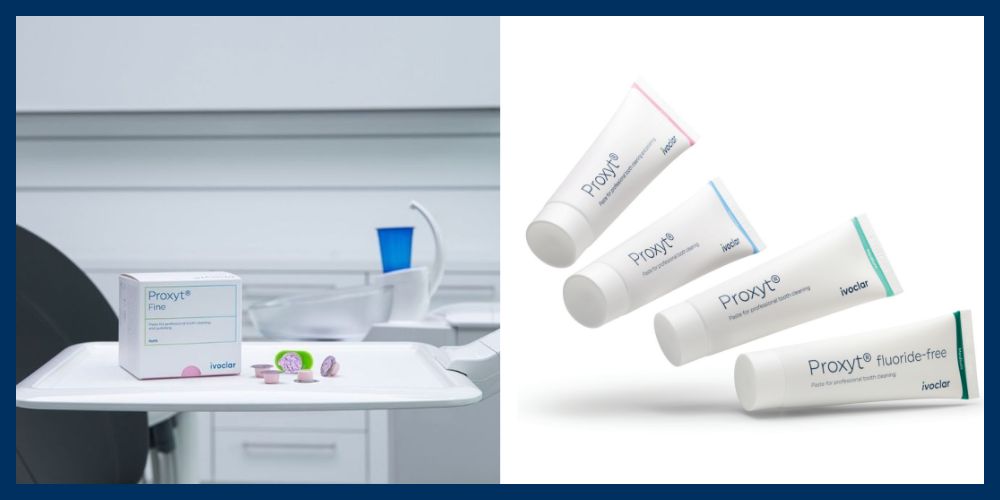
Prophy Powder vs. Prophy Paste: Key Differences for Dental Professionals
In dental cleanings, the choice between prophy powder and prophy paste is important for patient outcomes and experience.
Each has unique characteristics and applications. Here's a comparison to help determine when to use each and understand their benefits and limitations.

What is Prophy Powder?
-
Prophy Powder is an air-polishing powder designed for use with air polishing devices.
Prophy powders typically consist of substances like sodium bicarbonate, glycine, or calcium carbonate. They are specifically formulated for removing soft deposits, stains, and biofilm from teeth without abrasive contact with the enamel.
Prophy powder is primarily made up of mild abrasives designed for efficient but gentle removal of biofilm and surface stains on teeth.
The specific ingredients depend on the type of prophy powder and its intended application. Here are some common types:
1. Sodium Bicarbonate:
This is one of the most widely used prophy powder ingredients due to its moderate abrasiveness and effective stain-removal properties. Sodium bicarbonate is ideal for patients without severe sensitivity and works well on extrinsic stains.
2. Glycine:
Known for its very low abrasiveness, glycine is a gentler option and is suitable for patients with gum disease, dental implants, or sensitivity. It’s ideal for subgingival biofilm removal and patients with orthodontic appliances.
3. Calcium Carbonate:
This powder has a moderate level of abrasiveness and is a good alternative for effective stain removal. Calcium carbonate is often used when a balance of effectiveness and gentleness is needed.
4. Erythritol:
A newer ingredient in prophy powders, erythritol is even finer and less abrasive than glycine, making it suitable for patients with high sensitivity and for use on subgingival areas. Erythritol also has natural antibacterial properties, which can be beneficial for patients with periodontal concerns.
5. Calcium Phosphates:
Some prophy powders include calcium phosphates, like hydroxyapatite, which can help remineralise enamel while cleaning. This is an added benefit for patients with early enamel erosion or demineralisation.



What is Prophy Paste?
Prophy Paste is a gritty, fluoride-infused paste used with a rubber cup (known as a prophy cup) attached to a slow-speed handpiece. It's abrasive enough to remove surface stains and plaque but gentle enough for enamel.
Prophy pastes are made up of a mixture of binders, humectant, colouring agents, preservatives, fluoride, flavourings and abrasive material. Either chalk, also called whiting or calcium carbonate, or pumice is used as the abrasive in most dental prophy pastes.
- Abrasives: Prophy paste contains varying levels of abrasives (like pumice, silica, or calcium carbonate) to help remove stains and polish the enamel. It is available in different grit levels—fine, medium, and coarse—depending on the intensity of cleaning required.
- Fluoride: Many prophy pastes include fluoride, which helps in strengthening enamel and preventing future decay after cleaning.
- Flavouring Agents: To improve the patient experience, prophy paste often comes in various flavours, like mint, cherry, or bubble-gum.
- Desensitising Agents: Some formulations include ingredients like potassium nitrate to help reduce sensitivity during and after the cleaning process.
Composition and Abrasiveness
Prophy Powder: Often less abrasive than paste, especially when using glycine-based powders. This makes it suitable for patients with sensitive teeth, gum recession, or implants. The powder grains are fine and dissolve more easily.
Prophy Paste: Available in various grit levels (coarse, medium, and fine) to suit different levels of stain. While generally more abrasive than powder, paste is excellent for polishing teeth surfaces after the initial cleaning, leaving teeth smooth and polished.
- Coarse: The most abrasive prophy paste. Used for the removal of plaque and excessive staining.
- Medium: Medium grit is used for the removal of plaque and suitable for most patients.
- Fine: The least abrasive prophy paste. Used for polishing and removal of light plaque.
Application Method
Prophy Powder: Used in air-polishing systems that deliver powder mixed with pressurised air and water. This method allows for quick and effective removal of stains from all angles, even hard-to-reach spots between teeth.
Prophy Paste: Applied using a rotary handpiece with a rubber cup attachment. It requires a more hands-on approach and may take longer than powder but allows for precision on specific teeth or areas with heavy staining.
Patient Comfort
Prophy Powder: Generally considered more comfortable, especially for those with tooth sensitivity. The spray approach reduces physical contact with the teeth and gums, minimising irritation. Patients also appreciate its faster, more gentle experience.
Prophy Paste: Some patients may feel more discomfort with paste due to the gritty texture and increased contact pressure from the rubber cup, especially on sensitive areas.
Effectiveness in Stain Removal
Prophy Powder: Excellent for removing superficial stains and biofilm, especially in patients with orthodontic brackets, implants, or restorations. It may be less effective on deeply embedded stains.
Prophy Paste: Provides thorough polishing that is effective at removing stubborn stains and producing a high-gloss finish. The paste leaves a smooth surface that resists plaque accumulation.
Suitability for Special Cases
Prophy Powder: Suitable for patients with periodontal disease, braces, or dental implants since it causes minimal abrasion on these sensitive structures. It can also be useful in cases where minimal contact is preferred.
Prophy Paste: Works best on patients without extensive dental restorations and those who require intense stain removal. The paste can be adapted in grit to accommodate lighter or more intense polishing needs.
Pros and Cons Summary


Prophy Powder vs. Prophy Paste: Making the Right Choice
Both prophy powder and prophy paste play essential roles in dental hygiene.
For patients with more sensitive oral health needs or light staining, prophy powder is an excellent choice. For patients with heavier staining or those who prefer a classic polish, prophy paste is likely more effective.
By choosing the appropriate tool, you can provide better outcomes and a more comfortable experience for your patients.
